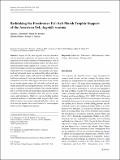Rethinking the Freshwater Eel: Salt Marsh Trophic Support of the American Eel, Anguilla rostrata
Author(s)
Dionne, Michele; Eberhardt, Alyson L.; Burdick, David M.; Vincent, Robert E
Download12237_2015_Article_9960.pdf (692.1Kb)
PUBLISHER_POLICY
Publisher Policy
Article is made available in accordance with the publisher's policy and may be subject to US copyright law. Please refer to the publisher's site for terms of use.
Terms of use
Metadata
Show full item recordAbstract
Despite the fact that Anguilla rostrata (American eel) are frequently captured in salt marshes, their role in salt marsh food webs and the influence of human impacts, such as tidal restrictions, on this role remains unclear. To better understand salt marsh trophic support of A. rostrata, eels were collected from tidally restricted and unrestricted salt marsh creeks within three New England estuaries. Gut contents were examined, and eel muscle tissue was analyzed for carbon and nitrogen stable isotope values and entered into MixSir mixing models to understand if salt marsh food sources are important contributors to eel diet. Data suggest that eel prey rely heavily on salt marsh organic matter and eels utilize salt marsh secondary production as an energetic resource over time, and thus can be considered salt marsh residents. Gut contents indicate that A. rostrata function as top predators, feeding primarily on secondary consumers including other fish species, crustaceans, and polychaetes. Higher A. rostrata trophic position measured upstream of reference creeks suggests that severe tidal restrictions may result in altered food webs, but it is not clear how this impacts the overall fitness of A. rostrata populations in New England salt marshes.
Date issued
2015-03Department
Massachusetts Institute of Technology. Sea Grant College ProgramJournal
Estuaries and Coasts
Publisher
Springer-Verlag
Citation
Eberhardt, Alyson L., David M. Burdick, Michele Dionne, and Robert E. Vincent. “Rethinking the Freshwater Eel: Salt Marsh Trophic Support of the American Eel, Anguilla Rostrata.” Estuaries and Coasts 38, no. 4 (March 31, 2015): 1251-1261.
Version: Author's final manuscript
ISSN
1559-2723
1559-2731